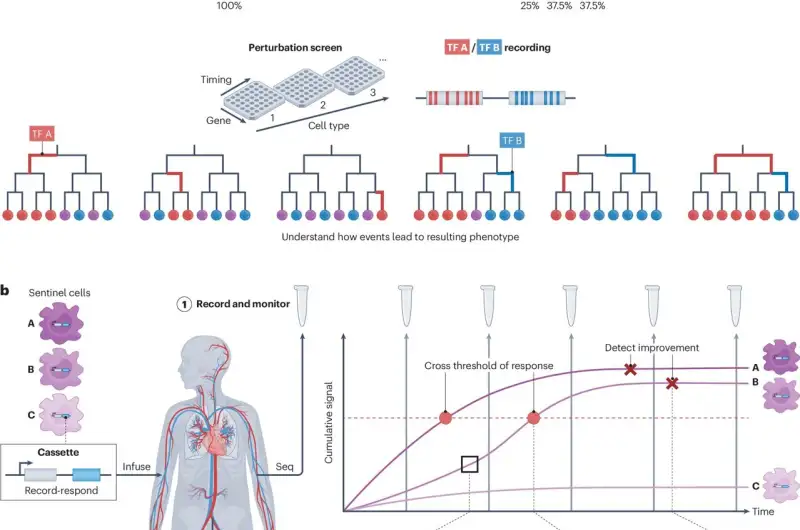Breakthrough in DNA-Based Recording Opens New Frontiers in Disease Diagnosis and MonitoringResearchers from institutions including UCLA and the University of Washington have pioneered genetically engineered sentinel cells capable of recording molecular and physiological changes directly into their genomes.
This innovation promises to revolutionize disease diagnostics, monitoring, and treatment by providing a continuous and comprehensive history of cellular states, surpassing the limitations of traditional diagnostic methods.The Challenge of Capturing Cellular HistoriesConventional diagnostics rely heavily on methods like blood tests, urine sampling, and tissue biopsies. While these techniques provide valuable insights into a cell’s current state, they fail to capture the dynamic sequence of events leading to the observed condition. Reconstructing cellular histories typically requires repeated sampling and analysis, which is invasive, time-consuming, and prone to selection bias.This inability to track cellular processes in real time poses significant barriers to understanding developmental processes, disease progression, immune responses, and treatment efficacy.
Sentinel cells, equipped with cutting-edge DNA-based recording technology, offer a transformative solution.How Sentinel Cells WorkSentinel cells are engineered to act as biological data recorders. Through advanced genome-editing tools such as CRISPR systems, these cells:Record Internal Data: Capture molecular and physiological signals directly in their DNA.Maintain Long-Term Records: Store data across multiple cell divisions, ensuring a continuous record of cellular changes.Secrete Information: Produce detectable proteins or nucleic acids that can be retrieved non-invasively from blood, urine, or stool samples.
By placing these cells at targeted locations in the body, researchers can gather comprehensive, tissue-specific data over time, offering insights into both the current state and the developmental history of tissues.Applications in HealthcareSentinel cells hold immense potential across several domains:Disease Diagnosis and Early DetectionSentinel cells can continuously monitor molecular changes, enabling early detection of diseases such as cancer, autoimmune disorders, or neurodegenerative conditions.
This approach minimizes the need for invasive diagnostic procedures.Tracking Disease ProgressionBy recording longitudinal cellular data, these cells can provide a detailed picture of how diseases evolve, helping researchers and clinicians identify critical intervention points.Personalized Treatment PlansSentinel cells can monitor individual responses to treatments, allowing healthcare providers to adjust therapies in real time for maximum efficacy.Insights into Developmental and Immune ProcessesThese engineered cells can document how immune responses and developmental processes unfold, offering valuable data for medical research and drug development.Real-World ExamplesGut Monitoring with Engineered BacteriaResearchers engineered Escherichia coli to function as sentinel cells in mice. These bacteria recorded their transcriptional responses during gut transit, providing insights into nutrient availability, acid stress, inflammation, and interactions with other microbes. By analyzing fecal samples, researchers retrieved this data non-invasively.
COURIER System for Cell TrackingAnother breakthrough, the COURIER system, involved sentinel cells exporting RNA barcodes packaged in protective nanoparticles. Sampling these barcodes allowed researchers to monitor thousands of distinct cell clones over time, enabling precise tracking of cellular responses to treatments.Safety and Future DevelopmentsTo ensure safety, sentinel cells can be engineered with:Kill Switches: Small-molecule-activated mechanisms to eliminate the cells if necessary.Tumor Suppressors: Built-in safeguards to prevent potential risks like uncontrolled cell growth.Future advancements could integrate programmable logic circuits into sentinel cells, allowing them to analyze recorded data and execute targeted responses, such as destroying diseased tissues or modulating immune system activity.
The Vision for TomorrowThe potential of sentinel cells extends beyond diagnostics. These engineered cells could redefine our approach to monitoring health, managing diseases, and understanding biological processes. By combining non-invasive data collection with real-time monitoring and advanced analytics, sentinel cells represent a critical step toward personalized and predictive medicine.This innovation not only enables better health outcomes but also deepens our understanding of the intricate mechanisms that govern life itself—ushering in a new era of precision healthcare.

















+ There are no comments
Add yours